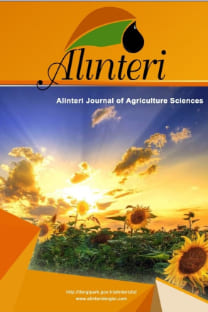Organic Agriculture Potential of Eastern Black Sea Region
Mankind caused a lot of harm to their environment unintentionally during agriculture. Thus nowadays production techniques that are compatible with nature, making the right use of the resources, targeting sustainable development, looking after animal welfare are beginning to spread throughout the world. Especially organic agriculture among those techniques gained a seat as it depends on customer preference. Organic agriculture that has the following five fundamental features: compatibility to nature, self sufficiency, sustainability, welfare, traceability began with the production of dried grape, dried figs, dried apricots and nuts in our country during the 1980s with the contractual agriculture system intending to export. During the following years, hardshell and dried fruits, frozen fruits and vegetables, fresh fruits and vegetables, spices and legumes followed the previous ones in export. Also, production and exportation of rose water, rose oil, olive oil, cotton and textile products increased considerably. In our country where there is a wide variety of products for organic agriculture, in eastern black sea region tea and nuts are the most cultivated products. Organic agriculture is carried out in every province of the region, the contribution of provinces in percentage as follows: Rize 42%, Ordu 25%, Artvin 13%, Trabzon 10%, Gumushane and Giresun 5%. Organic stock raising is done only in Gumushane and Ordu. Gümüşhane has the most promising potential for organic stock raising.
___
Anonymous, 2017a. http://www.cografya.gen.tr/egitim/ bolgeler/karadeniz.htm (Erişim Tarihi: 08.08.2017)Anonymous, 2017b. http://www.tarimkutuphanesi.com/ ORGANIK_TARIM_00583.html (Erişim Tarihi: 11.08.2017)
Anonymous, 2017c. http://www.tarim.gov.tr/Konular/ Bitkisel-Uretim/Organik-Tarim/Istatistikler (Erişim Tarihi: 10.08.2017)
Atiker, M., 2004. Organik tarım nedir?. Araştırma Raporu. Konya Tic. Odası Etüd- Araştırma Servisi. 40/40, 8s.
Bayram, B., Yolcu,H. ve Aksakal, V., 2007. Türkiye’de organik tarım ve sorunları. Atatürk Üniv. Ziraat Fak. Derg. 38 (2), 203-206, ISSN: 1300-9036
Çavdar, Y., 2003. Organik tarıma genel bir bakış ve organik su ürünleri yetiştiriciliği. SÜMAE YUNUS Araş. Bülteni, 3:2. 14-17.
Ertem, A. ve Çiçekli, Ö., 2010. Niçin organik tarım yapmalıyız? Türkiye IV. Organik Tarım Semp., 28 Haziran-1 Temmuz, Erzurum, 171-173.
Külekçi, M. ve Aksoy, A., 2015. Türkiye’de organik hayvansal üretim; mevcut durum ve geleceği. Doğu Karadeniz II. Organik Tarım Kong., 6-9 Ekim, Pazar/ Rize, 66-75.
Okcu, M., Okcu, Z., Kalkışım, Ö. ve Karabulut, B., 2013. Gümüşhane ilinde organik tarım. Türkiye V. Organik Tarım Semp., Bildiriler Kitabı- 2. 25-27 Eylül, 319-324.
Özcan, M. ve Yazıcıoğlu, E., 2015. Doğu karadeniz bölgesinin organik bahçe bitkileri yetiştiriciliğine geçişinde çevresel etkiler. Doğu Karadeniz II. Organik Tarım Kong., 6-9 Ekim, Pazar/ Rize, 140-146.
Öztürk, A, İ., 2004. Türkiye’de organik bal üretimi. I. Uluslararası organik hayvansal üretim ve gıda güvenliği kong.. 28 Nisan–1 Mayıs,, s.111.
Tekeli, A., 2017. Organik hayvancılık ve önemi. Ç.Ü. Ziraat Fak. Zootekni Böl. http://www.zootekni.org.tr/u pload/File/ORGANK%20HAYVANCILIK%20ve%20NEM%20 PW.pdf (Erişim Tarihi: 10.08.2017)
Walaga, C., M. Hauser, R. Devle and F. Nagawa, 2005. Promoting organic agriculture in uganda. LEISA, Magazine on Low External Input and Sustainable Agric., December 2005, (21) 4: 9-11.
Yavaş, İ. ve Akgül, H.N., 2015. Organik tarım ve ege bölgesinde faaliyet gösteren ticari firmaların potansiyeli. Tralleis Elektronik Derg. (4). 26-37
Yavuzer, Ü. ve Bengisu, G., 2015. Organik Hayvancılık. Nobel Akademik Yayıncılık. 117s.
- ISSN: 2564-7814
- Başlangıç: 2007
- Yayıncı: Adem Yavuz SÖNMEZ
Sayıdaki Diğer Makaleler
Organic Agriculture Potential of Eastern Black Sea Region
Determination of Some Biological Control Agents Against Alternaria Fruit Rot in Quince
Nasibe TEKİNER, RECEP KOTAN, ELİF TOZLU, Fatih DADAŞOĞLU
Effects of Some Stabilizers on the Textural Properties of Set-Type Yogurt
Emine MACİT, M. Murat KARAOĞLU, İHSAN BAKIRCI
HASAN HALİLOĞLU, VEDAT BEYYAVAŞ
BAHADIR SAYINCI, BÜNYAMİN DEMİR, Ruçhan ÇÖMLEK, MUSTAFA GÖKALP BOYDAŞ
